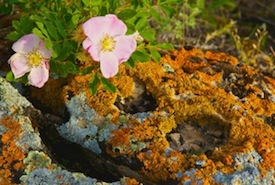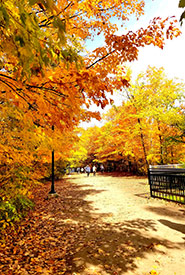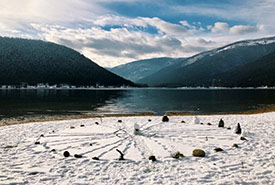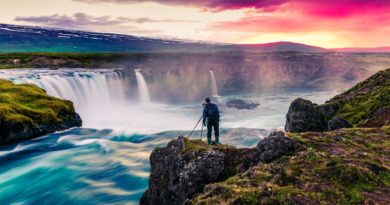NCC: Nature therapy (part two): Expressive art therapy

Rose, Maymont, SK (Photo by Don Dabbs)
In part one of our nature therapy series, we heard from a Regina-based mom and social worker about how nature-based art projects have helped her tap into the creative side of her mind and how the experiences have benefitted her mentally during these uncertain times. For part two of this blog, I thought it would be interesting to dive more into the therapeutic aspect of nature-based art.
Related content:
I was introduced to expressive art therapy three years ago. My daughter was three months old, and I was struggling with debilitating post-partum anxiety. I was introduced to an expressive art therapist in Regina. I don’t consider myself an “artsy” person at all, so I was pushed beyond my comfort zone in what turned out to be one of the most rewarding and meaningful experiences of my post-partum life. As I created art and opened an idle part of my brain while sitting and talking with other new moms, my perspective changed. I was able to finally relate and communicate my feelings in a healthier way. For that I am forever grateful, and I hope that learning about art therapy can help others.
Emily Hammer is a professional art therapist with Sunrise Art Therapy in Saskatoon. Although I have yet to meet Emily in person, we have spoken quite a bit over the past few months. It is important that knowledgeable people like Emily are given a platform during this time, as we continue to build our relationship with nature on our journey to mental and physical well-being.
KB: What is art therapy?
EH: Art therapy is the combination of traditional talk therapy combined with a creative process. Art is a great way to explore feelings that may be hard to talk about. It can also help calm the nervous system, by stimulating relaxation and stress reduction.
KB: How can art therapy connect to or be practised in nature?
EH: Being in nature reduces stress, blood pressure and stress hormones. Creating art in nature increases the positive benefits, and the art can be as simple or as elaborate as you want! Try a hobby that you already enjoy (e.g. knitting, drawing, painting, etc.) on a deck, in a backyard or other outdoor spaces. For times that you can’t get outside, including natural materials in your art can bring some of the benefits of being in nature indoors. For example, with seniors who are living in home care, I like bringing in seasonal “treasures” like fallen leaves, fresh blooms and smooth river rocks for them to craft with or just touch and feel to remind them of nature.
KB: What are the benefits of art therapy?
EH: Art therapy can increase self-regulation (the ability to manage one’s behavior in appropriate manners) and help build emotional language and positive coping skills. It can also increase self-esteem, assist in coping with life transitions and increase self-awareness and discovery. Art therapy is also useful for treating many mental health diagnoses and developmental delays. It’s especially useful for people who don’t want to talk or are unable to, as it uses the creative process as a means of communication.
During school, I found that simple activities such as finger knitting helped me to stay grounded and “in the now” during classes when I was feeling overwhelmed with clinical placements, assignments and other coursework. The rhythmic movement and soft yarn helped to keep me focused, and it was not disturbing to anyone else in the class. Even now, I will still knit when I’m feeling stressed.
KB: Why is art therapy important during a time when a lot of us are experiencing higher levels of stress and anxiety?
EH: Creating art is an activity that can ground us, relieve stress and allow us to be in the present. My approach to art therapy is based on current neurobiological research, and the activities that I choose are based on how our brain copes with trauma. In the early stages, which we are all experiencing during this pandemic, activities that soothe and regulate the nervous system are important. Rhythmic activities such as knitting, crocheting, beading and drawing mandalas, and sensory activities like clay, slime, finger painting and playdough, ork with the lower brain and nervous system to lower stress and anxiety. Grounding in our bodies and regulating ourselves are crucial in times of crisis, which makes art-making a great way to cope.
Examples art therapy activities that you can try
1. Take photos
One of the easiest activities to do outside is to take photos. Photo art therapy is the fastest and easiest way to be brought into the moment and save a piece of it. This can be done anywhere and is fast and easy. I worked for one month on a project where every time I was in nature and saw something that caught my eye and brought me joy, I would snap a photo of it. At the end of the month I had tons of photos of neat, unusual or beautiful things! It helped to ease me in to being more comfortable outdoors and taking time to appreciate the world around me more.

Maple trees (Photo by Kayla Burak/NCC staff)
I remember being in awe of a maple tree showing its fall colours! Doing this activity reminds us to slow down and take time to enjoy what the natural world has to offer.
2. Nature mandalas
One of my favourite outdoor art activities is creating nature mandalas. This activity is good for people of all ages and can be done on the ground or a table. Mandalas have been a spiritual practice for many cultures from all over the world, including the sand mandalas created by Buddhist monks. They use coloured sand to create incredibly elaborate round designs, sweeping them away once completed.

A nature mandala (Photo by Randi Martin)
To create your own mandala, start in a yard, park, beach or field, collecting objects that catch your eye. Please ensure that you are only using materials found in your backyard, or an area that is not protected or sensitive. If possible, place the materials back when your activity is complete. Then, starting from the middle, arrange the materials in concentric circles. These can be made large and small, detailed or simple, and in pairs or alone. Try taking turns placing “rings” to see what you can create with a partner. This photo from my colleague Randi Martin is a large and simple nature mandala that was created collectively during an outdoor retreat.
3. Watercolour landscapes
Another activity that I love for all ages is small-scale watercolour landscapes. While sitting outside, try using watercolour paints on a postcard or smaller sized paper (thick and slightly textured is best) to capture something that you see; it can be as small as a single flower, or the whole scene. Watercolour is a really forgiving medium and suits the landscape style perfectly. Look often between your subject and your painting, and don’t worry about capturing it exactly.
KB: What would you say to someone who is thinking about taking up a nature-based art activity like this but isn’t sure how or where to start?
EH: I think the best way to start is doing an art activity or hobby that is already familiar and enjoyable to you is to do it outdoors! It’s a great way to ease in and experience the healing and soothing benefits in an accessible way. Notice how your body and mind feel before starting, and afterwards, make notes of any changes.




